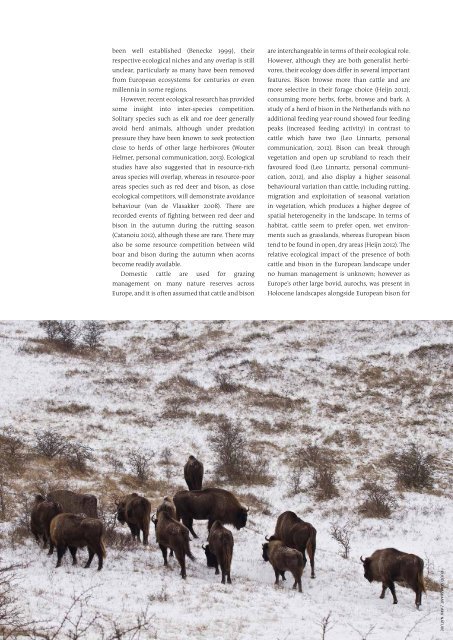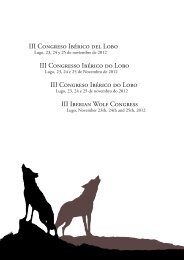Bison-Rewilding-Plan-2014
Bison-Rewilding-Plan-2014
Bison-Rewilding-Plan-2014
- No tags were found...
You also want an ePaper? Increase the reach of your titles
YUMPU automatically turns print PDFs into web optimized ePapers that Google loves.
een well established (Benecke 1999), theirrespective ecological niches and any overlap is stillunclear, particularly as many have been removedfrom European ecosystems for centuries or evenmillennia in some regions.However, recent ecological research has providedsome insight into inter-species competition.Solitary species such as elk and roe deer generallyavoid herd animals, although under predationpressure they have been known to seek protectionclose to herds of other large herbivores (WouterHelmer, personal communication, 2013). Ecologicalstudies have also suggested that in resource-richareas species will overlap, whereas in resource-poorareas species such as red deer and bison, as closeecological competitors, will demonstrate avoidancebehaviour (van de Vlasakker 2008). There arerecorded events of fighting between red deer andbison in the autumn during the rutting season(Catanoiu 2012), although these are rare. There mayalso be some resource competition between wildboar and bison during the autumn when acornsbecome readily available.Domestic cattle are used for grazingmanagement on many nature reserves acrossEurope, and it is often assumed that cattle and bisonare interchangeable in terms of their ecological role.However, although they are both generalist herbivores,their ecology does differ in several importantfeatures. <strong>Bison</strong> browse more than cattle and aremore selective in their forage choice (Heijn 2012),consuming more herbs, forbs, browse and bark. Astudy of a herd of bison in the Netherlands with noadditional feeding year-round showed four feedingpeaks (increased feeding activity) in contrast tocattle which have two (Leo Linnartz, personalcommunication, 2012). <strong>Bison</strong> can break throughvegetation and open up scrubland to reach theirfavoured food (Leo Linnartz, personal communication,2012), and also display a higher seasonalbehavioural variation than cattle, including rutting,migration and exploitation of seasonal variationin vegetation, which produces a higher degree ofspatial heterogeneity in the landscape. In terms ofhabitat, cattle seem to prefer open, wet environmentssuch as grasslands, whereas European bisontend to be found in open, dry areas (Heijn 2012). Therelative ecological impact of the presence of bothcattle and bison in the European landscape underno human management is unknown; however asEurope’s other large bovid, aurochs, was present inHolocene landscapes alongside European bison for16RUUD MAASKANT / ARK NATURE



